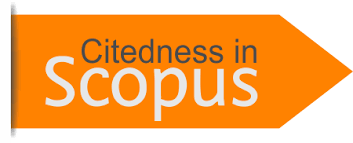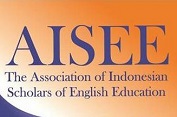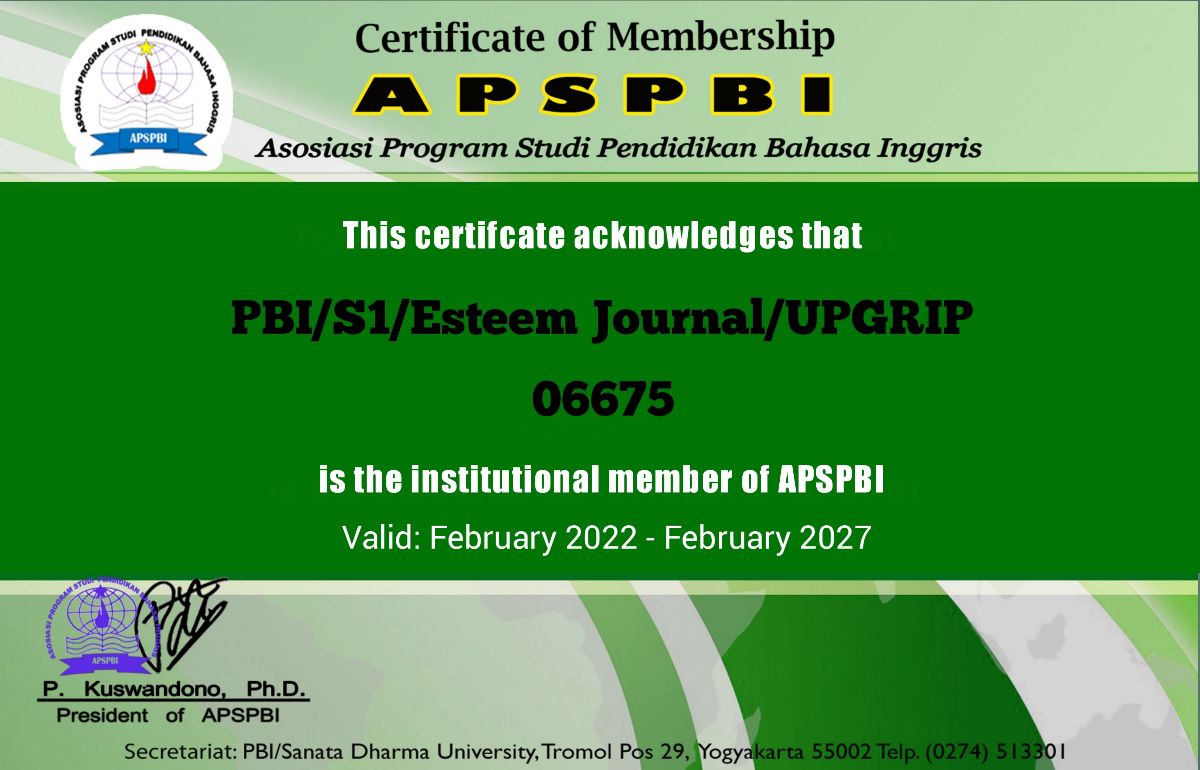AUDIO LINGUAL METHOD TO TEACH SPEAKING AND LISTENING SKILLS IN ENGLISH FOR NURSING COURSE
DOI:
https://doi.org/10.31851/esteem.v6i2.12318Keywords:
Audio Lingual Method, Speaking Skill, Listening Skill, English for Nursing.Abstract
The objective of this study was to create instructional techniques for teaching topics in the English for Nursing: Elementary Course using the Audio Lingual Method (ALM). The focus of the study was on developing speaking and listening skills, and the methodology used was design-based research. The study began by designing instructional materials that incorporated ALM techniques and then identifying the elements to evaluate the activities. After careful consideration, four ALM techniques were selected: repetition drill, chain drill, substitution drill, and backward build-up. These techniques were applied to three out of the eight topics covered in the English for Nursing course, specifically Parts of the Human Body, Names of Departments in the Hospital, and Nurses' Duties in Wards.
References
Abdul, N. B. (2016). The Use of Audio-Lingual Method in Teaching Listening Comprehension at The Second Year Students of Smk Yapip Makassar Sungguminasa. Exposure Journal, 5(1), 1–23.
Baranovskaya, T., & Shaforostova, V. (2017). Assessment and Evaluation Techniques. Journal of Language and Education, 3(2), 30–38. https://doi.org/10.17323/2411-7390-2017-3-2-30-38
Bobosher Kizi, S. S. (2022). Audio-Lingual Method in Teaching Language and Its Benefits and Drawbacks. International Journal Of Literature And Languages, 02(05), 29–32. https://doi.org/10.37547/ijll/volume02issue05-06
Branch, T. D. and C. cation. (2006). Effective Student Assessment and Evaluation in the Classroom. Education, A. (2006). Effective Student Assessment and Evaluation in the Classroom. Teacher Development and Certification Branch)., 8 to 18.
Djauhar, R. (2021). The Grammar - Translation Method , The Direct Method , and The Audio - Lingual Method. Langua-Journal of Linguistics, Literature, and Language Education, 4(1), 84–88. Retrieved from www.jurnal.stkipkieraha.ac.id/index.php/langua
Ebrahimi, F., & Elahifar, M. (2021). Teaching Speaking and Listening Skills through Audio-Lingual Versus Conventional Methods of Instruction: Which Method Is More Effective? International Journal of Linguistics, Literature and Translation (IJLLT), 4(11), 71–81. https://doi.org/10.32996/ijllt
Ghofur, A., S. Degeng, I. N., Widiati, U., & Setyosari, P. (2017). The Effect of Communicative Language Teaching And Audio-Lingual Method on English Speaking Skill Across Different Learning Styles. LSCAC Conference Proceedings, International Conference on Language, Society and Culture in Asian Contexts, 1(3), 1. https://doi.org/10.18502/kss.v1i3.719
Iman, T. R. (2020). The Interference of Indonesian on English Second Language Writing. Journal of Languages and Language Teaching, 8(2), 170. https://doi.org/10.33394/jollt.v8i2.2466
Johnson, A. P. (2018). Communication Skills: Listening And Speaking. https://doi.org/10.2307/813264
Lousa, D. P., & Suryaman, M. (2022). Fun Learning To Improve Students’ Speaking Skill Through Audio Lingual Method In The Eyl Classroom. Jurnal Pendidikan Dan Konseling, 4(4), 6466–6472.
Mardhiyah, A., Jaya, A., & Uzer, Y. (2023). Improving Students’ Speaking Ability through Small- Group Discussion. ESTEEM Journal of English Study Programme, 6(1), 81–86. https://doi.org/10.22236/jer_vol2issue2pp130-138
Newton, J., & Nation, I. S. P. (2021). Teaching ESL EFL Listening and Speaking (Esl & Applied Linguistics Professional) (E. Hinkel, ed.). UK: Routlege.
Permadi Sukarman, E., & Algiovan, N. (2022). Comparative Study of Post-Marriage Nationality Of Women in Legal Systems of Different Countries International Journal of Multicultural and Multireligious Understanding The Use of Audio-Lingual Method in Improving Speaking Accuracy of Indonesian EFL Learne. International Journal of Multicultural and Multireligious Understanding, 9(2), 734–740. Retrieved from http://ijmmu.comhttp//dx.doi.org/10.18415/ijmmu.v9i2.3556
Rajagopalan, I. (2019). The Concept of Teaching. Journal of Philosophy of Education, 7(2), 7-5–8. https://doi.org/10.1111/j.1467-9752.1973.tb00470.x
Rao, P. S. (2019). The Role of English As Global Language. Research Journal of English (RJOE), 4(1), 21. https://doi.org/10.33387/j.edu.v19i1.3200
Safitri, N. Y., Sudirman, & Putrawan, G. E. (2019). The Implementation of Audio-Lingual Method in Teaching Speaking to The Second Grade Students of SMPN 1 Gadingrejo Pringsewu. Unila Journal of English Teaching, 8(1).
Septian, A. O., & Simaibang, B. (2023). Improving Students ’ Motivation and Speaking Ability Using Online. ESTEEM Journal Of English Study Programme, 6(1), 71–75.
Serri, F., Boroujeni, A. J., & Hesabi, A. (2012). Cognitive, metacognitive, and social/affective strategies in listening comprehension and their relationships with individual differences. Theory and Practice in Language Studies, 2(4), 843–849. https://doi.org/10.4304/tpls.2.4.843-849
Sidabutar, U. (2021). The Effect Of The Audio Lingual Method on Students’ Speaking Achievement. Jurnal Suluh Pendidikan, 9(1), 56–65. https://doi.org/10.36655/jsp.v9i1.537
Sihombing, R. E., Silalahi, Y. A., Sianturi, T. T., Panjaitan, K., & Napitupulu, S. (2022). Using Audio-Lingual-Method to Overcome Student’s Listening Problem In Senior High School Kartika Pematangsiantar. International Journal of Education and Humanities, 2(2), 42–47. https://doi.org/10.58557/ijeh.v2i2.74
Suhartini, T. (2022). Learning English Grammar Through Audio-Lingual Method ( a Case Study in Kumon Efl Ranggong , Makassar ). JoELS: Journal of English Language Studies, 1(1), 45–55. Retrieved from http://ojs.unsamakassar.ac.id/jel
Susanti, Y., Syahri, I., & Syahri, I. (2023). Improving the Motivation and Listening Ability of Eleventh Grade Students By Using Smart App Creator. ESTEEM Journal of English Study Programme, 6(1), 76–80.
Yavuz, F., & Celik, O. (2017). The importance of listening in communication. Global Journal of Psychology Research: New Trends and Issues, 7(1), 8–11. https://doi.org/10.18844/gjpr.v7i1.2431
Downloads
Published
Issue
Section
License
Copyright (c) 2023 Risa Arroyyani

This work is licensed under a Creative Commons Attribution-NonCommercial-ShareAlike 4.0 International License.
Copyright Notice
Authors who publish with this journal agree to the following terms:
In order to assure the highest standards for published articles, a peer review policy is applied. In pursue of the compliance with academic standards, all parties involved in the publishing process (the authors, the editors and the editorial board and the reviewers) agree to meet the responsibilities stated below in accordance to the Journal publication ethics and malpractice statement.
Duties of Authors:
- The author(s) warrant that the submitted article is an original work, which has not been previously published, and that they have obtained an agreement from any co-author(s) prior to the manuscript’s submission;
- The author(s) should not submit articles describing essentially the same research to more than one journal;
- The authors(s) make certain that the manuscript meets the terms of the Manuscript Submission Guideline regarding appropriate academic citation and that no copyright infringement occurs;
- The authors(s) should inform the editors about any conflict of interests and report any errors they subsequently, discover in their manuscript.
Duties of Editors and the Editorial Board:
- The editors, together with the editorial board, are responsible for deciding upon the publication or rejection of the submitted manuscripts based only on their originality, significance, and relevance to the domains of the journal;
- The editors evaluate the manuscripts compliance with academic criteria, the domains of the journal and the guidelines;
- The editors must at all times respect the confidentiality of any information pertaining to the submitted manuscripts;
- The editors assign the review of each manuscript to two reviewers chosen according to their domains of expertise. The editors must take into account any conflict of interest reported by the authors and the reviewers.
- The editors must ensure that the comments and recommendations of the reviewers are sent to the author(s) in due time and that the manuscripts are returned to the editors, who take the final decision to publish them or not.
Authors are permitted and encouraged to post online a pre-publication manuscript (but not the Publisher final formatted PDF version of the Work) in institutional repositories or on their Websites prior to and during the submission process, as it can lead to productive exchanges, as well as earlier and greater citation of published work (see The Effect of Open Access). Any such posting made before acceptance and publication of the Work shall be updated upon publication to include a reference to the Publisher-assigned DOI (Digital Object Identifier) and a link to the online abstract for the final published Work in the Journal.





























